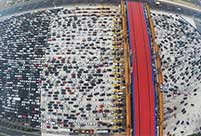


The fifth plenary session of the 18th Communist Party Central Committee is currently taking place and will result in the 13th Five-Year Plan. According to the original 12th Five-Year Plan, the aggregate population in China by the year of 2015 should reach 1.39 billion, with a natural growth rate of 7.2%.
However, statistics by the year of 2014 showed that the total population only reached 1.367 billion with 5.21% natural growth rate. Based on this trend, the country’s population by 2015 would only be around 1.374 billion, a fifteen million deficit of that was planned.
“The main reasons underlying the decreased natural population growth rate are the raised mortality rate and plateaued fertility desires", said Li Jianmin, head of the Institute of Population and Development of Nankai University.
Li pointed out that according to the current situation, the total population should be around 1.4 billion after the 13th five-year plan by 2020, definitely lower than the originally planned 1.45 billion. Therefore, the imminent goal, including its annual growth rate objectives, must be downgraded.
Researcher Zhang Yi of Chinese Academy of Social Sciences believes that with increased levels of economic and social development comes reduced fertility rate. Thus, the 13th five-year plan should further relax on the policy of population control.
“The result of the current two-child policy yields a less than optimum number of applicants and production, so the original plan may be outdated and is subject to further modifications”, says Zhang.
Zhang further adds that the direction of the changes in population policy should focus less on the restriction of growth, and more towards family support for those in need.
China applies a five-year period as a unit to mark the country’s short-term planning in terms of its national, economic, and social development. The first five-year plan started from 1953 to 1957.
 Love beyond limit of heights in the world
Love beyond limit of heights in the world
 When a Chinese woman marries an Indian man
When a Chinese woman marries an Indian man Photos of beautiful teacher hit the Internet
Photos of beautiful teacher hit the Internet Transparent Over-cliff Path Cracked Suddenly
Transparent Over-cliff Path Cracked Suddenly Bride-to-be tries to save drowned man
Bride-to-be tries to save drowned man Models change clothes on street in Hangzhou
Models change clothes on street in Hangzhou In pics: army beauties across world
In pics: army beauties across world Math teacher makes 'solar powered electric car'
Math teacher makes 'solar powered electric car' Heavy traffic turns expressway into huge parking lot
Heavy traffic turns expressway into huge parking lot Top 20 hottest women in the world in 2014
Top 20 hottest women in the world in 2014 Top 10 hardest languages to learn
Top 10 hardest languages to learn 10 Chinese female stars with most beautiful faces
10 Chinese female stars with most beautiful faces China’s Top 10 Unique Bridges, Highways and Roads
China’s Top 10 Unique Bridges, Highways and Roads Ballot bust-up
Ballot bust-up Wanda boss tops Forbes rich list
Wanda boss tops Forbes rich list Ties with EU can offset US-Japan alliance
Ties with EU can offset US-Japan alliance Mother-daughter mermaid team makes splash at Wuhan theme park
Mother-daughter mermaid team makes splash at Wuhan theme parkDay|Week